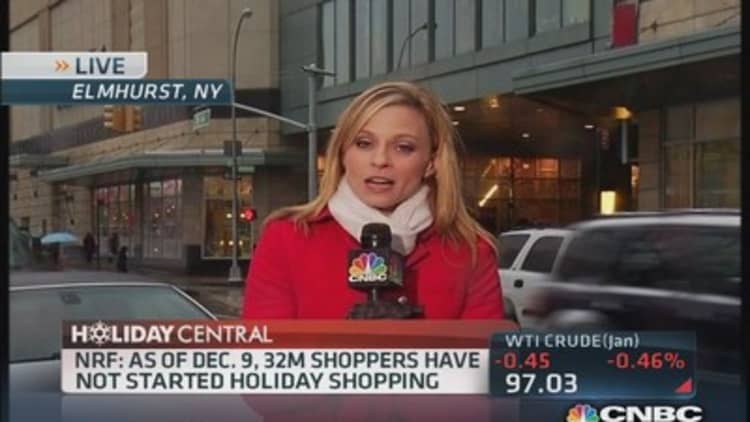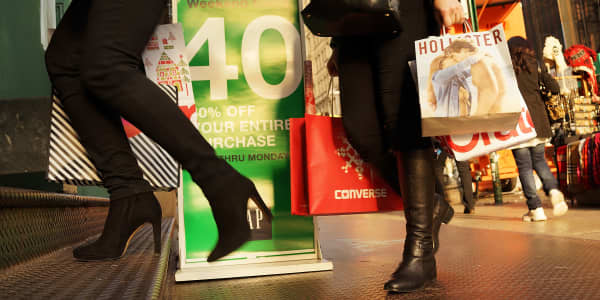Some e-commerce marketers are having a challenging holiday season, and they blame Google for it.
A change to Gmail that relegated retailers' emails to a separate inbox for promotions has had a big effect during the busiest shopping period of the year, according to three services that manage mass emails. And another change to Gmail, involving the way it shows images in messages, made it harder for retailers to track who opens their emails.
Google says it made the changes to improve the service for users, and that the changes could also be advantageous to marketers. Yet many email marketers — with whom Google competes for advertising — are still concerned.
"Everyone knows their best customers are at Gmail, so that's a problem," said Quinn Jalli, senior vice president of digital marketing services at Epsilon, a digital marketing firm. "It's less clicks from the most affluent portion of society, so it has a disproportionate impact on the bottom line for retailers."
(Read more: Shoppers, beware: Time is running out for online)
Google announced Thursday that it would automatically show images in Gmail messages (before, Gmail required an extra click to display images, largely because malware could be embedded in the images.) Google now stores images on its own servers, where it screens them for safety, instead of on the senders' servers.
The flip side for retailers is that by storing images on their own servers, they received much more information about Gmail users who opened their messages, such as their locations. Now, they know someone opened an email but not much more.
Half a year since Gmail introduced tabbed inboxes, fewer emails from retailers are being opened, according to three services that manage mass emails. And while some data showed that Gmail users nonetheless spent more money — perhaps because they proactively sought out retail emails in the promotions inbox — other data showed the opposite.
(Read more: Storms walloped retail traffic, ShopperTrak says)
Gmail shoppers, who tend to be wealthier and more tech-savvy, clicked on retail emails 14.5 percent more than Yahoo users before the change to Gmail, according to Epsilon. But by October, the difference had shrunk to 4.2 percent, indicating that Gmail users were ignoring marketing emails more often.
Accordingly, Epsilon's retail customers have reported a decline in revenue from Gmail users. And even when people did not open retail emails, the messages reminded people of the brand by showing up in their inboxes, and that effect is now lost, Mr. Jalli said.

Sailthru, another company that does email marketing, compared Thanksgiving weekend email activity year over year at Gmail, Yahoo, Hotmail and AOL. On Black Friday, open rates for Gmail declined 12.8 percent, while they rose 5.2 percent for the other three email providers. On Cyber Monday, open rates declined 7.5 percent at Gmail and increased 15.7 percent at the others.
Yet when Gmail users opened a retail email, they were more likely to spend money, Sailthru found. On Black Friday, revenue from each email that was opened climbed 44.8 percent at Gmail compared to 24.1 percent for Yahoo, Hotmail and AOL.
"Retailers will need to individually examine whether the gains in quality are enough to offset any loss in quantity from the dip in opens," said Cassie Lancellotti-Young, vice president of optimization and analytics at Sailthru.
More from the New York Times:
- Video Game for Toddlers, With a Plush Controller
- Instagram Direct and the Fracturing of Privacy
- A Digital Pen Combines Writing and Recording
A third email marketing service, MailChimp, analyzed 29 billion emails sent over six months and found that the open rates at Gmail declined 1.6 percent and click rates declined 1.4 percent — both significantly larger decreases than at Yahoo or Hotmail.
Meanwhile, the percentage of people who have unsubscribed from marketing emails — which MailChimp calls holiday email fatigue — increased at the other email providers but did not change at Gmail.
Matthew Grove, an engineer at MailChimp, concluded that the Gmail change is working because people seem less frustrated by promotions if they are not unsubscribing. But could it mean that people simply aren't seeing the retailers' emails at all?
(Read more: 10 apps to guide your holiday shopping crunch time)
—By Claire Cain Miller, New York Times




